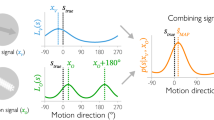Abstract
WHEN we perceive motion on a television or cinema screen, there must be some process that allows us to track moving objects over time: if not, the result would be a conflicting mass of motion signals in all directions. A possible mechanism, suggested by studies of motion displacement in spatially random patterns, is that low-level motion detectors have a limited spatial range, which ensures that they tend to be stimulated over time by the same object1–3. This model predicts that the direction of displacement of random patterns cannot be detected reliably above a critical absolute displacement value (Dmax) that is independent of the size or density of elements in the display1,4,5. It has been inferred that Anax is a measure of the size of motion detectors in the visual pathway1,3. Other studies, however, have shown that Dmax increases with element size6–8, in which case the most likely interpretation is thatDmax depends on the probability of false matches between pattern elements following a displacement. These conflicting accounts are reconciled here by showing that Umax is indeed determined by the spacing between the elements in the pattern, but only after fine detail has been removed by a physiological prefiltering stage: the filter required to explain the data has a similar size to the receptive field of neurons in the primate mag-nocellular pathway. The model explains why Dmax can be increased by removing high spatial frequencies from random patterns, and simplifies our view of early motion detection.
This is a preview of subscription content, access via your institution
Access options
Subscribe to this journal
Receive 51 print issues and online access
$199.00 per year
only $3.90 per issue
Buy this article
- Purchase on Springer Link
- Instant access to full article PDF
Prices may be subject to local taxes which are calculated during checkout
Similar content being viewed by others
References
Braddick, O. J. Vision Res. 14, 519–527 (1974).
Anstis, S. M. Phil. Trans. R. Soc. B290, 153–168 (1980).
Braddick, O. J. Phil. Trans. R. Soc. B290, 137–151 (1980).
Baker, C. L. & Braddick, O. J. Vision Res. 22, 1253–1260 (1982).
Sato, T. Vision Res. 29, 1749–1758 (1989).
Lappin, J. S. & Bell, H. H. Vision Res. 16, 161–168 (1976).
Cavanagh, P., Boeglin, J. & Favreau, O. Perception 14, 151–162 (1985).
Chang, J. J. & Julesz, B. Vision Res. 23, 639–646 (1983).
Morgan, M. J. & Cleary, R. F. Vision Res. (In the press).
Sato, T. Perception 19, A7 (1990).
Rodieck, R. W. & Stone, J. J. Neurophysin. 28, 883–849 (1965).
Marr, D. & Hildreth, E. C. Proc. R. Soc. B207, 187–217 (1980).
Marr, D. & Poggio, T. Proc. R. Soc. B204, 301–328 (1979).
Watt, R. J. & Morgan, M. J. Vision Res. 25, 1661–1674 (1985).
Schiller, P. H., Logothetis, N. K. & Charles, E. R. Nature 343, 68–69 (1990).
Crook, J. M., Lange-Malecki, B., Lee, B. B. & Valberg, A. J. Physiol. Lond. 396, 205–224 (1988).
Van Santen, J. P. H. & Sperling, G. J. opt. Soc. Am. 1, 451–473 (1984).
Bischof, W. F. & DiLollo, V. Vision Res. 30, 1341–1362 (1990).
Cleary, R. F. & Braddick, O. J. Vision Res. 30, 317–327 (1990).
Author information
Authors and Affiliations
Rights and permissions
About this article
Cite this article
Morgan, M. Spatial filtering precedes motion detection. Nature 355, 344–346 (1992). https://doi.org/10.1038/355344a0
Received:
Accepted:
Issue Date:
DOI: https://doi.org/10.1038/355344a0
This article is cited by
-
Invisible noise obscures visible signal in insect motion detection
Scientific Reports (2017)
-
Face perception: An integrative review of the role of spatial frequencies
Psychological Research Psychologische Forschung (2006)
-
Motion illusions as optimal percepts
Nature Neuroscience (2002)
-
Mechanisms of visual motion detection
Nature Neuroscience (2000)
-
Energetic motion detection
Nature (1995)
Comments
By submitting a comment you agree to abide by our Terms and Community Guidelines. If you find something abusive or that does not comply with our terms or guidelines please flag it as inappropriate.



